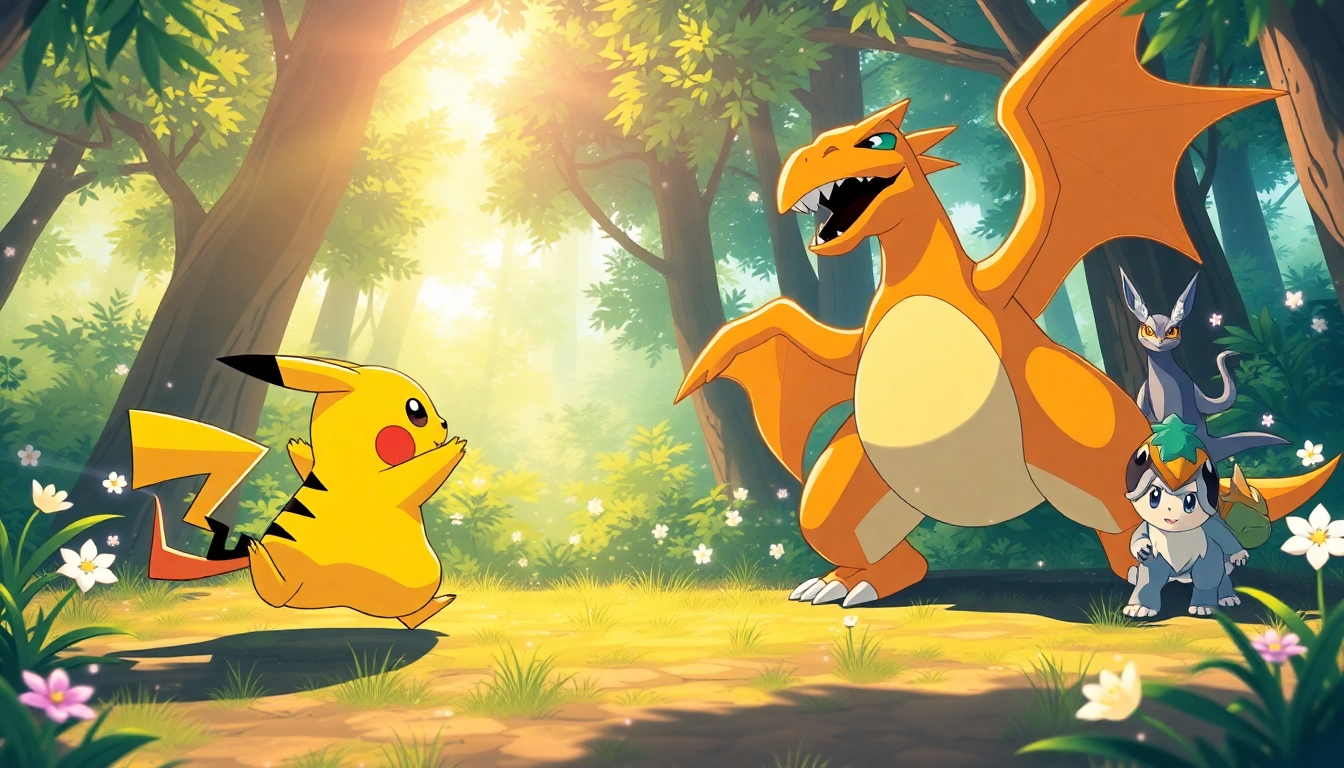The Evolution of Pokémon: From Games to Cultural Phenomenon
In the vast world of entertainment media, few franchises have captured the imaginations of fans like pokemon. Originally created in the 1990s, this multimedia franchise now encompasses video games, animated television shows, movies, trading cards, and an extensive array of merchandise. The Pokémon phenomenon represents not only an incredible commercial success but also a significant cultural impact that has influenced multiple generations. This article will explore the origins, evolution, and future of Pokémon, diving deep into its games and lore, while also examining strategies for engaging with its various media forms.
1. Origins of Pokémon: History and Creation
The inception of Pokémon can be traced back to Satoshi Tajiri’s childhood. He was fascinated by collecting creatures and envisioned a world where players could capture and train creatures in an immersive digital landscape. This idea culminated in the release of Pokémon Red and Green in Japan in 1996. Initially launched for the Game Boy, these games introduced a world teeming with unique creatures, each possessing varied abilities based on their type.
Co-developed by Game Freak and Creatures Inc., the Pokémon franchise’s first titles gained immediate popularity, setting the foundation for what would become a multi-billion dollar franchise. The core concept of training and battling monsters resonated with a large audience, particularly among children and young adults, who identified with the themes of friendship, adventure, and competition.
2. The Impact of Pokémon Games on the Industry
The early games utilized a turn-based battle system which inspired many subsequent role-playing games. As technology improved, so did the complexity of Pokémon games; newer iterations, such as Pokémon Gold and Silver, introduced features like breeding and day-night cycles, enhancing the gameplay experience.
Moreover, multiplayer connectivity features allowed players to trade and battle each other, fostering a sense of community that became a hallmark of the franchise. These innovations not only set Pokémon apart from its competitors but also revolutionized how video games engaged audiences, making multiplayer experiences an industry standard.
3. Cultural Significance and Media Adaptations
Beyond video games, Pokémon branched into animation, beginning with its television series in 1997. The show has since become a central pillar of the franchise. An enduring symbol of childhood nostalgia, it features iconic characters like Ash Ketchum and Pikachu, captivating audiences with themes of friendship and perseverance.
The Pokémon movies and merchandise, including toys and apparel, have further solidified its cultural significance. Notably, even as the series evolved through different generations, the core message of growth and teamwork remained consistent. Pokémon has transcended the realm of entertainment, becoming a zeitgeist force that influences fashion, language, and social trends worldwide.
Understanding Pokémon Types and Their Strategies
1. Exploring Pokémon Types and Attributes
In the world of Pokémon, understanding types is crucial for trainers as each Pokémon is categorized into various types such as Water, Fire, Grass, Electric, Psychic, among others. These types dictate a Pokémon’s strengths, weaknesses, and the effectiveness of their moves during battles. For instance, a Water-type Pokémon is strong against Fire-type Pokémon but weak against Electric-type ones.
This type system introduces a strategic element to battles, requiring trainers to consider their team’s composition and adapt their tactics based on the opponent. The intricate balance of type advantages and disadvantages adds depth to gameplay, encouraging trainers to analyze and strategize for each encounter.
2. Best Strategies for Type Matchups
When engaging in battles, one of the essential strategies is to select Pokémon that possess advantageous type matchups against opponents. For example, leading with a Grass-type Pokémon against a Water-type opponent will likely yield favorable outcomes. This tactical approach not only increases the probability of victory but also enhances the gameplay experience by requiring trainers to think critically.
Additionally, utilizing a diverse team composition that incorporates different types can protect against various strategies employed by opponents. Knowledge of the type chart is crucial; as trainers familiarize themselves with these interactions, they can build more effective teams and execute superior strategies during competition.
3. Building Effective Pokémon Teams
Constructing an effective Pokémon team involves more than simply selecting powerful creatures. Trainers must consider a balance of types, roles, and synergy among their Pokémon. Each member of the team should fulfill a specific role—such as tank, damage dealer, or support—to ensure comprehensive coverage against various opponents.
In addition to team composition, trainers should keep in mind the movesets of their Pokémon. Selecting moves that capitalize on type advantages while also incorporating versatile coverage moves increases effectiveness in varied battle scenarios. Many trainers find success by employing Pokémon with differing roles and versatile moves, creating a well-rounded team capable of adapting to any challenge.
The Pokémon Trading Card Game: Rules and Community
1. Introduction to Pokémon Trading Card Game
The Pokémon Trading Card Game (TCG) debuted alongside the video games and has grown into a significant component of the franchise. In this strategy-based game, players build decks of cards, each representing Pokémon, moves, items, and special conditions. The objective is to defeat the opponent by knocking out their Pokémon and collecting prize cards.
The strategic layer of the TCG requires players to think through their plays and anticipate opposing moves. With continual updates and expansions, the game encourages players to adapt and refine their strategies, maintaining high engagement levels within the community.
2. Basic Rules and Gameplay Mechanics
The Pokémon TCG functions on a turn-based system where each player draws a card, plays cards to the field, and attacks with Pokémon to inflict damage upon opponents. Understanding the mechanics of energy cards and how they interact with Pokémon moves is crucial for success. Each Pokémon has specific energy requirements for using their abilities, demanding strategic management of resources throughout gameplay.
Additionally, incorporating strategies based on the card types—such as Pokémon-EX, GX, and V cards—brings diversity to deck-building. Players invest time in designing decks that align with their play styles, resulting in a robust competitive environment.
3. Engaging with the Pokémon Trading Card Community
Participating in local championships, tournaments, and online forums is an effective way to engage with the Pokémon TCG community. These events often foster camaraderie among players who share tips, strategies, and experiences. Online platforms and forums provide ample opportunities for collaboration and discussion, as players from across the globe exchange deck-building tactics and gameplay experiences.
Moreover, the Pokémon community thrives on content creation—streaming gameplay, producing tutorials, and analyzing tournament results. Contributing to forums or social media discussions helps aspiring trainers improve their skills while promoting a sense of belonging in the broader Pokémon community.
Understanding Pokémon Lore: The Mythology Behind the Creatures
1. The Mythos of Legendary Pokémon
The lore surrounding legendary Pokémon is one of the most captivating aspects of the franchise. These rare Pokémon, often seen as deities within the Pokémon universe, are frequently interconnected with myths and legends surrounding the creation and balance of the world. Characters such as Arceus, known as the “Original One,” are said to have shaped the Pokémon world and its creatures, enriching the narrative depth of the franchise.
Beyond their powerful abilities in battle, legendary Pokémon embody themes such as creation, destruction, and the delicate balance of nature. This multifaceted storytelling engages fans and enhances emotional investment as trainers capture and train these mythical creatures.
2. Notable Pokémon Stories and Their Messages
The narrative behind Pokémon often conveys significant life messages, particularly around friendship, teamwork, and perseverance. Common storylines include trainers overcoming adversities to achieve their goals, highlighting inspirational themes that resonate across various demographics. Notable examples include early games depicting the journey of novice trainers who grow and evolve alongside their Pokémon, leading to a sense of accomplishment that mirrors real-life challenges.
Beyond individual character arcs, Pokémon often explores the complexities of good versus evil, particularly through antagonistic characters who seek to exploit Pokémon for personal gain. These narratives encourage players to reflect on moral dilemmas and the value of collaboration over competition.
3. The Interconnected Universe of Pokémon
The Pokémon universe is recognized for its vast interconnectedness, with lore and characters that tie different games and series together. From regions like Kanto, Johto, and Sinnoh to networks involving other characters and Pokémon, the franchise has constructed a cohesive world that inspires creativity within its fanbase.
This interconnectedness not only provides a rich backdrop for storytelling but also encourages exploration within the games. Players are motivated to uncover hidden connections and references from previous generations, fostering a sense of nostalgia and anticipation for future installments.
Future of Pokémon: Trends and Innovations in Gaming
1. Upcoming Pokémon Games and Features
As technology continues to evolve, so does the Pokémon franchise. Upcoming releases suggest an increasing focus on augmented reality experiences and multiplayer interactions, enhancing the immersive qualities of the games. Players can look forward to future games that offer deeper storylines, richer graphics, and innovative gameplay mechanics that leverage advancements in technology.
Furthermore, the continued expansion of the Pokémon universe hints at new regions and creatures, entrenching the narrative of exploration and discovery that has made Pokémon an enduring favorite among fans.
2. Evolving Gameplay Mechanics and Technology
The gameplay mechanics are continuously refined, aiming to meet the expectations of modern players who seek innovation. Features that enhance player experience—such as customization options for characters and Pokémon—are expected to be at the forefront of future games. Innovations in AI programming will lead to more challenging opponents, crafting a competitive environment that captures the original spirit of Pokémon battles.
Advancements in graphics and animation technology are also anticipated to bring the Pokémon world to life in unprecedented ways, further captivating audiences in as they quest to “catch ’em all.”
3. Community Predictions and Expectations
As Pokémon continues to expand and evolve, the community is excited about potential shifts in the franchise. Expectations include a deeper exploration of lore and character development, with fans eager for narratives that delve into the complexities of Pokémon interactions. Moreover, with the rise of competitive gaming, many speculate a stronger emphasis on eSports and structured tournaments to capture a more adult audience.
Feedback from the community concerning their desires for new features or types can shape future developments, as the franchise remains committed to listening to its player base. In this collaborative spirit, the future of Pokémon appears bright, with limitless potential for growth and innovation.







